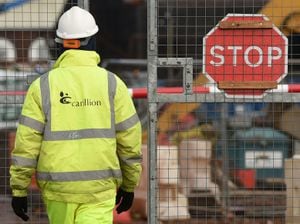600 days on: Business leaders warnings over risk of another Carillion
Business leaders have warned that “another Carillion” could emerge unless closer links are forged between industry and government.

The construction giant, which was based in Wolverhampton, collapsed in January 2018 with a debt pile of around £1.5bn, leading to its entire UK workforce of around 19,000 being made redundant.
Unsustainable financial troubles and taking on too many major contracts – many of them in deals struck with Whitehall – have been blamed for the demise of what was the UK’s second biggest construction firm, leading to probes over poor management and the failure of auditors to take steps to tackle the crisis.
Six hundred days on from the liquidation of Carillion, CBI West Midlands director Richard Butler says that while the majority of partnerships between the public and private sectors are successful, more needs to be done to stop other major firms from failing.
“There are still too many examples of poor commercial behaviours across government, leading to ineffective partnerships with its suppliers and unsatisfactory outcomes for members of the public,” he said.
It comes as plans were today laid out for a ‘Carillion law’ that would aim to stop auditors from missing the signs that major firms were in financial difficulties.
The legislation has been drawn up by Lib Dem campaigners in the Black Country and will be proposed by MPs as an amendment to the next Finance Bill.
Carillion fiasco leaves crumbling legacy
It is 600 days today since the collapse of Carillion – and the ramifications are still being felt across the country.
An official investigation into whether there was any criminal wrongdoing by the Wolverhampton-based construction giant’s directors is still ongoing, with a ruling expected in 2021.
The Financial Reporting Council is undertaking several investigations into Carillion’s financial reporting and the accuracy of its auditing processes.
Some of the firm’s 20,000 UK-based staff are bidding for justice over the failure of bosses to consult them before making them redundant.
Firms in the enormous supply chain have continued to go out of business – an estimated 30,000 of them were left out of pocket – while the lending criteria for smaller businesses has tightened to such an extent that for many of them, securing loans has become exceedingly difficult.
And pensioners took a severe hit to their benefits after the scheme was left with a near billion pound funding shortfall.
After all this time, big questions still remain over how a company that was supposedly “too big to fail” managed to collapse in such a swift and disastrous manner in January 2018.
For current evidence that Carillion’s demise will leave an abysmal legacy, look no further than the projects that have been left behind.
Before its liquidation the firm was employed as a main contractor on nearly 450 projects, including the construction of hospitals, schools, rail schemes and defence sites.
The unmitigated disasters include the Midland Metropolitan Hospital in Sandwell and the Royal Liverpool Hospital, both massively over budget and facing repeated delays.
Add to the list the Aberdeen bypass, which was finally completed in February at a final cost that is expected to be more than £1bn – almost quadruple its original budget – and the Rotherham to Sheffield tram train.

Carillion was also up to its neck in HS2 contracts, its involvement piling further pressure on a project already creaking under financial strain.
Undoubtedly, the contractor’s two most high-profile problem jobs in the UK were former PFI hospital builds that were plunged into turmoil the moment Carillion went into liquidation.
The case of the Midlands “super hospital” is a particularly painful example.
Billed as the solution to the region’s healthcare needs when it was first mooted for a cost of £350m, the site has long been seen as a necessity due largely to the overflowing A&E departments and lengthy waiting lists for operations at other hospitals in the West Midlands.
After an initial six month delay due to engineering issues, Carillion’s collapse saw work stop altogether for nine months.
And despite Balfour Beatty being brought in as the new contractor, the only work that has taken place in the last 21 months has been remedial in nature.
An opening date of Spring 2019 was pushed back to 2022, while the cost has rocked by 36 per cent to £475m.
Whether either of those two targets are met remains to be seen, with hospital trust bosses barely able to hide their frustration as the project lurches from one delay to another.
It is still not known when work will resume, although bosses are hopeful of getting the green light before the end of the year.
A similar sorry story has unfolded with another Carillion landmark project, the redevelopment of the Royal Liverpool Hospital, which was originally due to open in March 2017 at a cost of £335m.
As with the Midland Met, all work stopped at the site in January 2018, but by that stage serious issues had already appeared.

The 646-bed hospital faced delays after asbestos was found on site and remedial building work was also needed, while it has now emerged that three floors will need to be completely rebuilt after structural flaws were identified with Carillion’s work.
Bosses have given up setting a completion date so as not to raise expectations and Liverpool Mayor Joe Anderson has called for an inquiry into the project.
Five years after the first spade entered the ground, the hospital remains a wreck and will cost an estimated £120m over budget.
Carillion’s collapse also hindered the progress of the Aberdeen bypass in the north east of Scotland. The 36-mile long road was finally completed earlier this year at a cost that is expected to exceed £1bn – almost quadruple its initial budget. With Carillion off the scene, its partner on the project Galliford Try was forced to tap shareholders for £150m to cover costs, while inevitable delays to construction followed.
The tram scheme in South Yorkshire was, in many respects, a disaster from start to finish.
When it was first mooted in May 2012 the initial cost to modify the national rail network to allow trams to run on it was estimated at £18.7m, with a completion date of December 2015.
By 2017 the cost had tripled to £75.1m with work due to be finished by May 2018, after claims that the work was more “technically challenging” that expected. When Carillion collapsed, the project was a staggering £60m over budget. It finally launched last October.
Birmingham’s ambitious Paradise Circus development provides another tale of woe.
In the months after Carillion’s collapse the project ran out of money as it emerged that it had bust its budget by around £100m.

Some of the serious issues with Carillion projects date back to long before there was even an inkling that the company was in trouble.
The firm was the proud builder of Manchester’s tallest block, Beetham Tower, which it completed to great fanfare in 2006.
But by 2014 problems had started to emerge with the glazing in the 47-storey building.
Within weeks more than 150 large window units had been identified as having the “potential for failure”, prompting Carillion to take steps to ensure the safety of all 1,350 glass boxes.
A short term fix was brought in, but no long term solution had been put in place by the time Carillion went bust. The result is that Ground Rents Income Fund, the investor which owns the freehold of the tower, has been left with a repair bill of around £4m.
While contractors, businesses, local authorities and beleaguered Whitehall bureaucrats battle to pick up the pieces, it remains questionable whether the lessons from Carillion’s failure have been fully taken on board.
It is impossible to rule out the possibility of another construction giant going to the wall.
Kier, the construction, services and property giant has been on a downward spiral for the last three years, losing more than 90 per cent of its value.
In recent months it has announced 1,200 job losses in a bid to cut its debt pile and avoid the fate of Carillion, which for years was its main competitor.
The warning signs are there, and while Carillion’s demise sparked a degree of reform in terms of how contracts are handed out, there is plenty of work still to be done.





